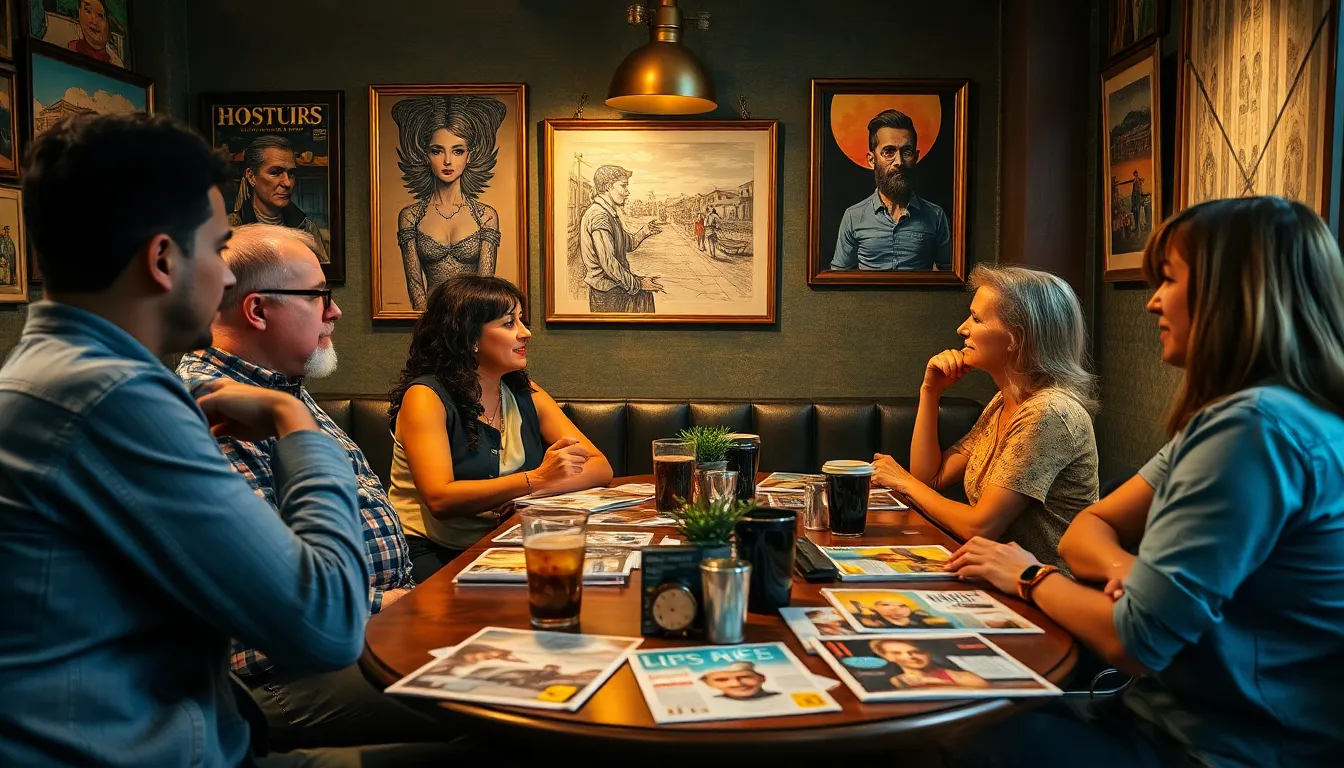In the vast digital landscape, where cat videos reign supreme and memes are a form of currency, online culture magazines have emerged as the intellectual oasis. These platforms dive deep into the trends, art, and societal shifts that shape our everyday lives, all while keeping it entertaining and engaging. Who says you can’t learn something new while chuckling at a witty article?
With a blend of humor and insight, online culture magazines invite readers to explore everything from the latest fashion fads to thought-provoking social commentary. They’re not just websites; they’re vibrant communities where ideas collide and creativity flourishes. So grab your favorite beverage, settle in, and get ready to discover the heartbeat of today’s culture—one click at a time.
Table of Contents
ToggleOverview of Online Culture Magazine
Online culture magazines play a critical role in shaping modern digital interactions. These platforms not only highlight emerging trends but also provide insights into the evolving landscape of art and society. Creativity fuels their content, enabling writers to explore diverse topics ranging from fashion to social issues. Engaging storytelling captivates audiences while fostering a sense of community among readers.
Content diversity in these magazines attracts a wide range of readers. Various authors contribute their unique perspectives, allowing for enriched discussions on contemporary matters. Readers often appreciate the blend of humor and thoughtful analysis found in articles. Popular themes include art exhibitions, music reviews, and fashion critiques, each catering to specific interests.
Accessibility remains a crucial feature of online culture magazines. Readers can easily navigate through different sections, leading to an enjoyable experience. With a few clicks, audiences discover captivating articles that resonate with their own interests. Interaction fosters a vibrant community where feedback and commentary encourage dialogue among users.
Emerging technologies further enhance the experience provided by these platforms. Multimedia elements like videos and podcasts accompany written content, adding depth to the reader’s understanding. Regular updates ensure that the content stays relevant and reflects current societal developments.
By creating a welcoming space, online culture magazines encourage exploration and open-mindedness. They invite readers to step outside their comfort zones, engage with varied viewpoints, and connect over shared interests. Such engagement ultimately strengthens the bond among readers, contributing to the magazine’s ongoing success in the digital realm.
Key Features and Content

Online culture magazines offer unique insights into contemporary life, blending creativity and critical thought. Their diverse offerings engage readers by fostering rich discussions on various subjects.
Editorial Style
Editorial styles vary significantly among online culture magazines. Some use a casual tone that resonates with younger audiences, while others adopt a more formal approach aimed at industry professionals. Engaging narratives often incorporate humor, allowing readers to connect with the content. Editorial teams prioritize authenticity and clarity, ensuring that voices reflect varied backgrounds and experiences. Many magazines encourage contributors to express personal perspectives, which enhances the overall richness of the content. This collaborative effort results in a distinct editorial voice that speaks to a wide array of interests.
Topic Diversity
Topic diversity remains a hallmark of online culture magazines. These platforms explore themes such as art, fashion, technology, and social issues, appealing to broad audience segments. Regular features include artist spotlights, music reviews, and film critiques, providing ample material for readers. Contributors approach topics from various angles, fostering thought-provoking discussions. Readers encounter articles that address current trends while reflecting on historical contexts, deepening understanding of contemporary issues. By showcasing a range of voices and topics, magazines promote an inclusive environment where everyone’s interests find a home.
Audience Engagement
Online culture magazines thrive on engaging their audiences through multiple channels and interactive formats. These platforms prioritize community connection and encourage active participation.
Social Media Presence
Social media plays a pivotal role in audience engagement for online culture magazines. Platforms like Instagram and Twitter amplify reach and provide immediate interaction opportunities. Followers receive real-time updates on trending topics and new articles. Each post invites discussion, allowing readers to share opinions and ideas. Visual content often sparks interest, with photos and videos drawing viewers into deeper conversations. Regularly posting engaging content fosters loyalty, ensuring that audiences remain connected and involved in ongoing discussions.
Reader Feedback
Reader feedback significantly shapes the content and direction of online culture magazines. Encouraging comments on articles and social media posts gives readers a voice, enabling them to share thoughts and reactions. This feedback loop often leads to content adjustments that reflect audience preferences. Surveys and polls are frequently used to gather insights on what readers want, ensuring relevance. Engaging with readers through personalized responses enhances the sense of community. By valuing reader input, magazines build trust and foster a collaborative environment that enriches discussions and content creation.
Impact on Cultural Discourse
Online culture magazines significantly influence cultural discourse by shaping conversations around contemporary issues. These platforms provide diverse perspectives on art, music, and social trends. Readers engage with thought-provoking content that fosters deeper understanding and encourages exploration of various viewpoints.
Regular features like artist spotlights and film critiques stimulate debates, enriching discussions within communities. Editorial teams prioritize authenticity alongside clarity, ensuring that each article resonates with its audience. When readers encounter entertaining narratives alongside critical analysis, they develop a connection to the content.
Social media platforms amplify the impact of online culture magazines, facilitating real-time interactions among readers and authors. As followers share articles or opinions, discussions expand beyond the confines of the magazine. Reader feedback directly informs future content, allowing magazines to adapt to audience preferences and trending topics.
Emerging technologies enhance reader engagement through multimedia formats such as videos and podcasts. Such features provide dynamic experiences that attract diverse audiences. This approach encourages open-mindedness and interactive dialogues around cultural phenomena, promoting a vibrant online community.
Accessibility remains vital in this landscape, enabling readers to navigate articles aligned with their interests easily. Magazines create welcoming spaces for creativity, encouraging contributions from various authors and perspectives. By embracing these dynamics, online culture magazines play an essential role in modern cultural conversations. They not only reflect current societal attitudes but also shape them through insightful commentary and community engagement.
Future of Online Culture Magazines
Online culture magazines will continue to evolve, embracing new technologies and trends to enhance reader experiences. Integration of augmented reality and virtual reality offers immersive storytelling capabilities, enabling audiences to engage with content in innovative ways. Multimedia formats such as interactive articles, video essays, and podcasts consistently draw in diverse readerships, catering to various preferences.
Content strategies increasingly focus on personalization, driven by data analytics. This approach curates articles that resonate closely with individual interests, leading to improved engagement and satisfaction among readers. Editorial teams will likely prioritize inclusivity, ensuring a range of voices contribute to narratives, reflecting the complexities of contemporary society.
Collaboration with creators and influencers amplifies magazine visibility in an ever-competitive space. Community-driven initiatives, including reader-generated content, further enhance engagement, fostering a sense of ownership among followers. As interactions deepen, magazines encourage discussions that extend across social media platforms, keeping topics alive well beyond original publication.
Sustainability becomes a vital consideration, prompting many online culture magazines to adopt environmentally-conscious practices. This shift aligns with audience values, appealing to readers who prioritize ethical consumption. Moreover, maintaining a commitment to authenticity and transparency remains essential for building trust within the community.
Audience feedback shapes editorial focus, allowing responsiveness to reader interests and societal shifts. Surveys and engagement metrics play significant roles in determining what topics gain prominence, ensuring magazines stay relevant in rapidly changing cultural landscapes. Overall, online culture magazines are poised for dynamic growth, adapting to emerging trends while fostering vibrant, engaged communities.
Online culture magazines are redefining how audiences engage with art and society. By blending humor with insightful analysis they create dynamic platforms that resonate with diverse readers. The accessibility and variety of content foster vibrant communities where creativity thrives.
As these magazines continue to evolve they’ll embrace new technologies and trends to enhance user experiences. The integration of multimedia elements and personalized content will keep them relevant in an ever-changing digital landscape. With their commitment to authenticity and community engagement they’ll remain vital in shaping cultural discourse and connecting individuals over shared interests. The future looks bright for online culture magazines as they adapt and grow while promoting inclusive conversations.



